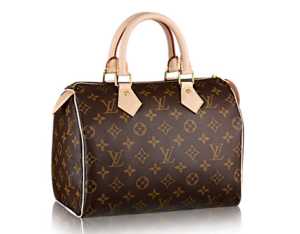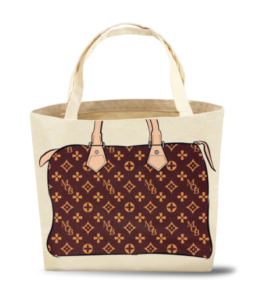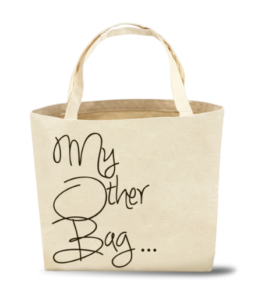he Second Circuit Court of Appeals last week affirmed a district court’s dismissal of luxury brand Louis Vuitton Malletier, S.A.’s suit against My Other Bag, Inc., seller of canvas tote bags featuring the text “My Other Bag…” on one side and drawings meant to evoke luxury handbags on the other.
Background:
 MOB sells canvas tote bags meant to depict designer brands. One of its canvas bags features a drawing concededly meant to evoke classic Louis Vuitton handbags by using colors, graphic lines, and patterns that resemble Louis Vuitton’s famous Toile Monogram, a repeating pattern featuring three stylized flower designs and the interlocking, stylized letters “L” and “V.” MOB’s canvas tote replaced the “L” and “V” with an interlocking “MOB,” but otherwise utilized the Monogram’s famous stylized flower elements. Louis Vuitton brought suit against MOB in 2014, alleging both trademark and copyright claims. This post focuses on Louis Vuitton’s trademark claims, primarily because the Second Circuit’s ruling did not discuss each of the typical fair use factors under copyright law in depth.
MOB sells canvas tote bags meant to depict designer brands. One of its canvas bags features a drawing concededly meant to evoke classic Louis Vuitton handbags by using colors, graphic lines, and patterns that resemble Louis Vuitton’s famous Toile Monogram, a repeating pattern featuring three stylized flower designs and the interlocking, stylized letters “L” and “V.” MOB’s canvas tote replaced the “L” and “V” with an interlocking “MOB,” but otherwise utilized the Monogram’s famous stylized flower elements. Louis Vuitton brought suit against MOB in 2014, alleging both trademark and copyright claims. This post focuses on Louis Vuitton’s trademark claims, primarily because the Second Circuit’s ruling did not discuss each of the typical fair use factors under copyright law in depth.
Trademark Dilution:


Louis Vuitton’s principal claim focused on trademark dilution by blurring, which refers not to consumer confusion, but to the gradual diminishment of a famous trademark’s ability to clearly and unmistakably distinguish a unique source of goods or services as a result of unauthorized use. (Classic examples of trademark dilution identified by the district court, and other courts, are “Buick Aspirin” or “Kodak Pianos”). Both federal and New York state trademark law provide a defense to dilution claims: a fair use of a trademark in connection with parody, criticism, or commentary does not constitute dilution.
Both the district court and Second Circuit focused on MOB’s parody defense, explaining that a successful parody communicates two simultaneous, contradictory messages: that it is the original, but also that it is not the original. The Second Circuit affirmed the district court’s finding that MOB’s bags were quintessential parodies: they reference, and indeed mimic, Louis Vuitton’s designs and handbags, communicating a connection with Louis Vuitton’s high-cost, luxury products, but do so in connection with an inexpensive, decidedly non-luxury item (i.e., a utilitarian canvas tote bag). The image of exclusivity that Louis Vuitton takes care to cultivate is the object of MOB’s parody. Whereas a Louis Vuitton handbag is an item its wearer would handle with care and use to display a certain status, MOB’s canvas tote bags are intended for utilitarian purposes, such as carrying groceries or gym clothes without much concern for everyday wear and tear.
Louis Vuitton argued that the fair use exception does not apply to MOB’s products because MOB uses Louis Vuitton’s trademarks as a designation of source for MOB’s own goods—the precise type of use that contributes to trademark dilution. However, as the district court determined, and the Second Circuit affirmed, MOB’s bags are designed to suggest that the wearer’s other bag—and not MOB’s canvas tote—is an expensive Louis Vuitton handbag; the text “My Other Bag…,” combined with the cartoon-like rendering of a Louis Vuitton handbag, builds sufficient distance between MOB’s everyday tote bag and Louis Vuitton’s high-end products, much like the bumper sticker on a low-end car might read “My other car is a Ferrari.”
Louis Vuitton further argued that the fair use exception is inapplicable to MOB’s products because the parody expressed by such products is part of a larger social commentary, and not a parody directed towards Louis Vuitton specifically. This argument was effective in a recent case involving a Hyundai advertisement. However, as the district court clarified (without comment from the Second Circuit), even if MOB’s products convey a message about luxury brands, generally, a parody defense is nonetheless available to MOB because MOB’s products parody Louis Vuitton’s goods specifically at least in part.
Both the district court and Second Circuit dismissed Louis Vuitton’s copyright infringement claim for similar reasons, focusing on MOB’s fair use.
Trademark Infringement:
The Second Circuit also affirmed the district court’s dismissal of Louis Vuitton’s trademark infringement argument, focusing on three particular factors:
- Obvious differences in MOB’s mimicking of Louis Vuitton’s trademark, specifically, MOB’s cartoon-like depiction of a Louis Vuitton handbag and the substitution of “MOB” in place of Louis Vuitton’s interlocking “L” and “V”;
- Lack of market proximity between the products at issue, in that MOB’s inexpensive totes, which are sold on MOB’s website, do not compete with Louis Vuitton’s expensive, luxury handbags, which are sold exclusively in Louis Vuitton’s stores and through its own website; and
- Minimal evidence of consumer confusion, which was particularly fatal to Louis Vuitton’s infringement claim given that MOB’s totes have been available for sale for several years; according to the district court, some evidence of actual confusion should have, by this point, become available if MOB’s use had created a genuine likelihood of confusion.
Conclusion:
Trademark owners should—indeed, must—protect their brands and police the marketplace in order to protect the continued viability and commercial value of their brands. However, the Second Circuit’s swift affirmation of the district court’s decision suggests that brand owners, before spending the time, money, and resources to undertake enforcement activities against a perceived infringer, should consider whether a parody defense may be available to the infringer and how strong that defense might be in the context of the situation. Brand owners should focus on consumer perception, paying particular attention to whether consumers are likely to believe that the allegedly infringing good or service originated with, or was endorsed by, the brand owner, using the parameters outlined by the district court and affirmed by the Second Circuit, or whether the fair use defenses in the dilution laws might be so strong as to create an uphill battle on a dilution claim. If there is a bright side for Louis Vuitton in the ruling, it is that even owners of the most famous trademarks can appropriately forgo enforcement in those situations that appear to involve protected fair use.
Filed in: Legal Blog
January 3, 2017